Jefferson Nickel Collection for sale.

Work done by my daughter with PaintDotNet.
Coins struck from the earliest hubs/dies became my Holy Grail.
$765,000 or best offer.
Corresponding through the PM Inbox
Additional feedback. https://forums.collectors.com/discussion/1008666/my-jefferson-nickel-collection/p1?new=1
Listen to Felix Schlag tell his life story.
http://www.felixschlag.com/audio/Story_Of_Jefferson_Nickel.mp3
All features in full detail on every coin! Deep hairlines, complete Monticello w/sharp window tops. end steps, everything! Clean profiles, many w/proof-like (PL) fields. An exhaustive collection of high-quality Jefferson nickels (JNs) business strikes (BS). 100+ PL, Semi PL BS (60 shown). 22 early set w/6 steps. Deep mirrored, high contrast proofs.
700+ highly detailed coins, a 35 year collection.
The hard element metal (nickel) made it very difficult for the US Mint to produce fully struck JNs!
https://www.pcgs.com/news/nickel-the-other-precious-metal
256 coins displayed, 1938 to 1970. 100 coins, 1971 to 2003.
https://forums.collectors.com/discussion/1030414/jefferson-nickel-collection-1971-to-2003/p1?new=1
1982-P & D Reverse of 1977 Type 1 pair offered in above link.
1938 to 1970 PL, SPL set within, 76 +1 of 78 dates. Only the 39D, 43/2P, 46D ov, 47D, 48D, 49D, 50D, 51D, 58D, 63D ov. are needed. Some are part of the main set.
30 PL, SPL Silver Wartime nickels; (2) 42P, (3) 42S, (3) 43P, 43/2P, (5) 43D, (3) 43S, 44P, (5) 44D, 44S, (2) 45P, (2) 45D, (2) 45S.
313 new coins, 60 photos added. See the Hard List.
The most lustrous coins are PL . Add a VEDS dish-like strike ..... the highest quality coin collected.
What's new? T=Toned 39-P DDR, 46-P, 47-S, 55-P, 40-S. WDS 54-S,1966 BS. 69-S, and 41-D. 02/2020 38-D, a 2nd 39-D T2 struck w/same dies, 43-D/D. 64-P. Colorful PL 1951-S and a SPL 1952-S. 2nd 1960-D.1951-D and a 1967 BS. 1948-D, 1949-D. Colorful PL 1939-S R38 MS65. Colorful 1940-P 65FS. 1953-D/Inv. D T. Colorful AU55 38-D. T 1944-P MS66. Colorful 42 T1 proof, DDR. 39 proof R38 Cam obv. 1961-D SEGS MS64 EDS PL 5533 QSC. 1954-D EDS FS w/lathe lines. 1949-D MS65FS EDS, toned. 42-S MS67 w/13 bands of color. 46-S PL. 64-D MS66 PL. 2 1938-S's. Colorful 39-P R40. 1938-P PL, 1947-P SPL, 1953-D PL. Six extraordinary unique coins in a 39-P R40 FS PL, 40-D FS PL, 41-D FS PL, 42-D FS PL, a 44-S FS PL and a 55-P FS PL. Colorful 69-S. 43-S PL. 44-D PL. 38-P. 48-S, 49-S. EDS 1953-S.. 40-S PL. 49-P, 1967 BS 3345 QSC. Colorful 39-S R38. Colorful 39-S R40. 39-S R40 64FS. Colorful 47-P. 64-P. 1942-D/Inverted D?, 1965 PL BS & 1966 BS, 68-D, 70-D PL, New pics 69-S and 70-S. 38-D, 40-D PL, 41-P PL, 41-P FS, 42-P PL T, 42-S FS PL, 43-P T, 43-P-, 43-S PL, 44-D FS, 46-P FS, 46-D 6 steps nick, 47-P FS, 48-P FS, 48-D 6 Steps, 49-P, 49-S FSn, 52-D FS, 53-P FS, 53-D FS, 54-P PL, 54-P FS, 55-P, 56-P FS, 56-P PL, 56-D FS, 57-P FS, 57-D PL, 59-P FS, 59-D FS, 60-P FS, 63-D FS, 2 1950 proofs, 50-P PL. 2nd 1942-D 6 PL video. 1967 SMS 5 Steps. Colorful 41 PR. HG SPL 1943/2-P w/video. 1939-D R40 FS, PL, Colorful. 43-P T. 1939-P Dbl Mont. 43-P. 1942-P PF, 44-P 6 steps. 38-D Colorful. 47-P PL T. 70-D PL. 58-D. 68-S. 58. 76-P. 68-S. 85-P Broadstruck. 51-D PL + video. 50-D PL video. 42 T1.
Individual coins in bold print listed for sale.
2-54-S, 56-D, 60, 60-D, 63-D, 64, 67 BS, 68-S, 1982-P & D Reverse of 1977 Type 1 pair
1941-D 6 PL. https://youtu.be/V0fkCnFqkoU
https://youtu.be/V0fkCnFqkoU
Displayed; 55 ANACS, 6 NGC, 85 PCGS, 3 SEGS, and 92 Raw coins.
264 encapsulated coins in total; 114 ANACS, 19 NGC, 127 PCGS, 4 SEGS All totals within -/+3, keep losing count. ![]()
Deciphering the finish, the background, will take time because there are many......
The strike and luster are absolutes! What's left....the condition.
If it's not VEDS, PL and colorful.....what do you have?
What is rarer to find? A VEDS strike? Proof-like fields? Mark-free surfaces? Natural toning?
What they will grade......well, someone with......
When collecting any modern series, VEDS and PL examples are possible but not for everyone.
Thomas Jefferson along with John Adams, Benjamin Franklin were on a committee to design our official national seal. Did Felix Schlag draw an abstract of an eagle on the Jefferson nickel?
What most collectors will never understand.....something about a coin needs to stand out! The strike, condition and luster!
How detailed Jefferson's hair, the Mont. can get....and few can, is there any wonder why the steps did/didn't strike up as well?
The coin makes the assigned grade look good.....not the other way around!
How many categories can you separate/group your coins into? VEDS, no marks, colorful...PL or not....
A strike-thru is not a nick as it occurs when the coin is struck but still can be ugly.
Marks on steps, a high point, are common. Mindless to dismiss high quality.......
The number of characteristics/distinguishing features/qualities a coin has determines its eye appeal and value!
Differentiating the strike between two coins.
Many collectors have the tourniquet too tight about the steps.
Worried only about the steps or the overall look of the coin?
Grading MS coins, noting each aspect 1 to 10 of strike, condition, luster! Exs; 777, 865, 696, 754.
What you like about a coin and whatnot will always tip the scales one way......
It takes "a great coin" to take a great photo.
The quality of strike, condition, luster...whatever the steps will tell you if you can upgrade.
What's rarer than a JN with full steps? A JN with a VEDS strike!
PL Jeff's are seldom encountered.... how do they grade?
We are the inspectors of a company's product. Does it meet your standards?
A seasoned collector wants/has all the details, continuously fine-tuning their selections!
A poor presentation of an artist's works comes from worn dies.
When the strike and luster measure up, any major marks?
An (FS) coin has 0 missing details!
A collection is appreciated for its consistency and quality.
Collector coins have all the details the sculptor carved/designed onto an 8 1/2" diameter round of clay/plaster.
Very-early-die-state (VEDS) details/strike sets a coin apart from coins with fewer details!
An HG colorful EDS coin won't always exhibit FS especially when PL. But if you can have all 5.....
Locating a VEDS example is the ultimate goal!
The most lustrous coins are PL! How does the luster compare........
An EDS PL piece has peak eye appeal!
Compensated steps come from worn dies.
The notorious missing step area under the 2nd pillar and strike-throughs on a coin, steps....forgivable!
Why settle for less when far better coins exist?
_A coin w/weak hair, window details, a flat ear or cheek but yet shows steps, an FS coin it is not! _
The very hard metal/element of "nickel" used in the coin blanks (25% versus 8.33% for others) makes assembling a complete collection of fully detailed Jefferson nickels almost possible! See collection!
Myth; "They're all alike with poor/soft strikes". Due to the lack of EDS examples, lower-quality coins are collected, certified, and traded.
The metal packs into whatever details are available.
The absolute true definition of FS, a Jefferson nickel with full complete details!
There's a direct correlation between a coin having steps and the stage/condition of the dies it arrived from. The degradation of a die occurs from striking many coin blanks. A working hub/die will eventually shed its sharp details upon making working dies/coins. As one detail/area of a coin deflates another balloons up. The step area is a low recess in the die, acts like a reservoir to take up the excess metal that was meant for those once-needle-sharp details, relocating to the steps to prevent excessive stress that may crack the die. The steps tend to become more complete as the overall strike/details become less complete.
Coins made with worn dies also have fewer nicks due to not having high points of detail to get nicked up.
And the compaction on the coin blank increases with worn dies, making the surfaces harder also preventing contact marks.
A coin collection is built with consistency! Weak details, a major mark, carbon spots, or a scratch....lack of luster or toning is just average, it's upgradeable! The most problematic eyesore is a worn-die strike. Mint state coins not all there ought not straight grade but given a details grade! There was a time all I cared about were the steps, how short-lived that was! Today, Poor strikes in a collection? Full strike, few marks, outstanding luster = High-quality coins!
Photos of steps not shown for every coin but are there!
3 to 6 qualities on a single coin is rare. The main 3; 1) Full Strike, includes steps, 2) Condition, includes 3) Luster. A bonus is 4) Toning, but shouldn't lessen the luster. But coins with 5) a Very Early Die State (VEDS) Strike and/or 6) Prooflike (PL) fields, are the grandest of them all! And 7) Frost or a "circ cam" look, (see 1944-S, 1951-S, 1958-D, (2) 1964-D) 8) Evidence; lathe lines. The challenge is....to maintain a 3 or above quality collection!
Jefferson nickels come in a range of strikes, conditions, and luster. Some have toned. Upgrading involves a better strike, fewer marks, grandiose luster. From weak to VEDS strikes, marky coins to mark-free, average luster to mirror PL fields....ugly-toned to spectacular ones, whatever the goal, persistence and dedication can guide you to improve the quality of your collection.
A flat ear or cheek or details missing on the windows or in Jefferson's hair/profile, carbon spots, major nicks in the focal area of the profile, in the fields are low-grade coins!
Emphasis/focus should always be given to the overall strike. not only the steps. Otherwise, you'll end up with coins to upgrade!
The key to building a great collection is to make certain all your coins have distinctive design features/elements! Fine-tuning your selections resembling the master hubs. Pristine mint bloom luster, in itself, is rare. If Jefferson's deep hairlines are shallow or the top lines on the windows are weak or missing or the end steps are mushy, scratches or carbon spots are visible, guess what? ** You not only have a crappy coin but also an over-graded one!
PL fields = higher luster. The most lustrous coins are PL!
A few coins have a very early die state (VEDS) strike but shy of 5 steps. It's not until other details in the die are reduced from striking many planchets. The metal meant for those once razor-sharp details, end up in the steps. When I say, "Had the dies taken on more wear, the steps could have been stronger", this is what I'm referring to. My search was for the most detailed examples with original mint state luster, not coins with mushy strikes i.e., compensated steps.
There are many more years of searching behind many of these coins than my 34+ years, coins from other collections. I wouldn't've acquired such great coins without their dedication and efforts. So...it's not just my opinion on these coins! But as coin collectors have done, forming clubs, writing books.... and the Jefferson nickel is a different animal due to the high content of the very hard element of "nickel", 25% versus 8.33% for other denominations. Its usage in coin blanks has and continues to play havoc with a serious collector's search for fully detailed, pristine coins.
Collecting by the strike, grade and steps.....maintaining a complete design......that the steps have not been helped.....
Coins with proof-like fields arrived from fresh, first-time used dies. Later made dies had fewer/missing details so less pressure was applied to extend the life of the hub/dies. So...not all PL coins have full details or full steps yet have nice eye appeal.
The Mont. steps were the last to strike up, being a low recess in the die. It was not until the dies became seasoned enough, had taken on a bit of wear before the metal could reach/flow to that area. The reason why we see mushy details but yet, razor-sharp steps, some w/6. This makes sense! Coins with weak/missing design features but show steps, I have termed as having, "compensated steps",
The most eye-appealing coins have the greatest amount of design features, how much of the original mint bloom luster remains. How well the coin has survived by the number of defects it may have. Eye appeal is based on all of these qualities combined! Toning? Hmm, where does it fit in? Toning is corrosion and should not over-power the mint luster.
Every mint bloom coin I examine, I look over the strike for weak details, for any distracting marks; spots, scratches, gouges, tarnish whether the coin deserves further observation. Planchets after 1950 had numerous marks.
https://www.usmint.gov/wordpress/wp-content/uploads/2019/09/coin_composition_changes.jpg
The photos without borders can be giganticized by right-clicking and selecting to open the image in a new tab.
This is not an accumulation of nickels with compensated steps!
Hard list; https://forums.collectors.com/discussion/147244/fs-jefferson-nickel-collection/p1?new=1
A 2nd set 1938 to 2003 (not complete) $41,000 omo. Not every coin would be of the highest grade. Most have complete strikes, a few with not-so-perfect or 5 steps. A 1939-PDS R38, 1953-S, 1954-S, 1960 to 1964-D. PL coins. No proof coins.
Regards Leon lestroup@msn.com
1938 PDS & 1939 PDS Rev. of 38 coins must have separation/a slight gap between the 4th and 5th steps under the 3rd pillar. This distinction/criterion is extremely rare and highly sought.
(All captions reference the coin below)
PL 1938-P To view a larger picture, right-click on an image to open a new tab. Applies to all black framed and Trueview pictures.
Less detail, it's FS....right?
An amazing 4.50 steps strike. ![]()
Had the design features in the dies taken on more wear, more metal would have reached the steps. A genuine FS coin does not have weak details and filled-out steps.
How strong, full, sharp the details, how lustrous, perhaps proof-like and as mark-free, is the goal.
Precision detail, lustrous, flawless!
The Master Hubs were allowed to rest 10-12 years between the 1st, 2nd and 3rd sets of Master dies. The design ends up getting older than the coin as the years go by!
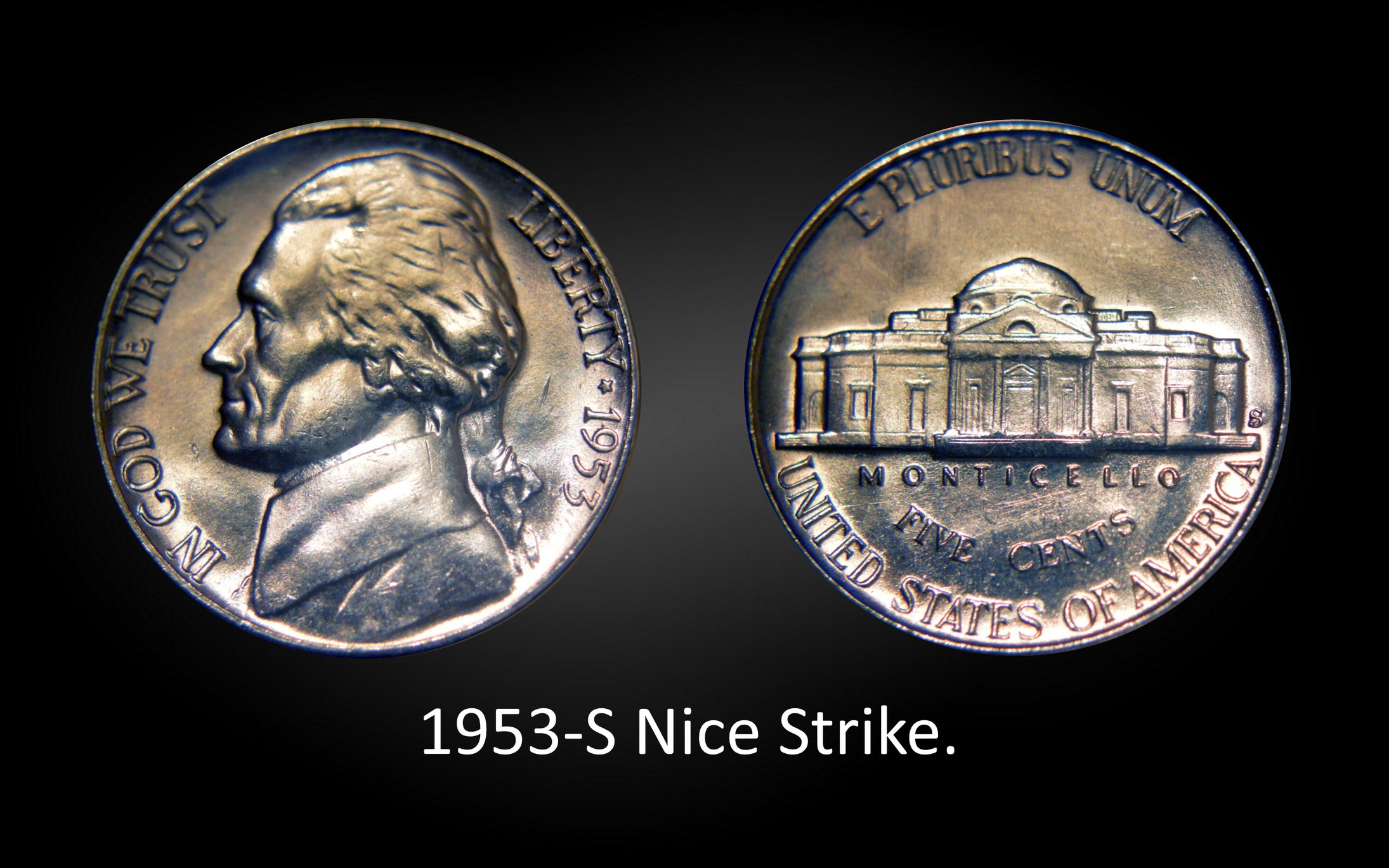
ANACS MS67 5 Steps, charcoal surfaces. 
Pretty PCGS AU55 Suffered from album paper burn. 





Dipping a coin to remove its toning will ruin it, gives it an unnatural appearance. Applying a cleaning agent cannot restore the original skin/mint bloom luster. Dipping only eats up the colors. The translucent crystallization of the rust/tarnish remains.
It's very difficult to locate early proofs that have not been dipped/cleaned/ruined/messed up, and carbon spot-free. 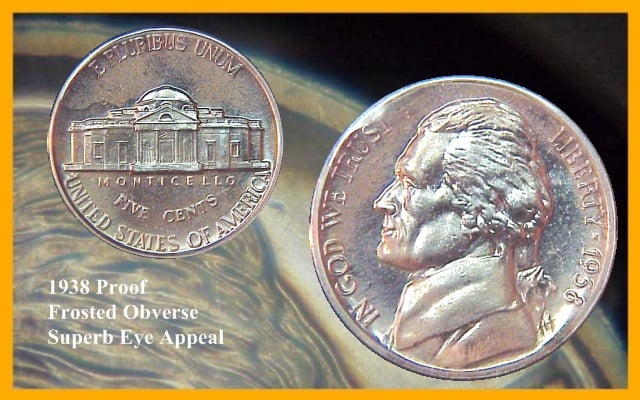
6 wavy steps.
Cameo obverse. Also a DDR-018
White lustrous example. Lathe bit cutting lines on reverse 8 to 11 O'clock.
There's a myriad of ways collections are built/assembled. A matched set in the best strike, condition and steps. The strike/details must be maintained before we count the steps. Otherwise, you'll only be cheating yourself from a higher quality coin.
MS65 and up Jefferson nickels must have complete design features: deep hairlines, a well-defined Monticello portico, detailed windows, square top digits, side/end steps. All original design features/details must be present on a coin designated FS. The metal for those once sharp details end up in what I have termed, "compensated steps".
So....ideally, a collector's coin should exhibit a very detailed strike. (if this is one's goal) This collection has given many gratifying hours/years of enjoyment, with many coins very unique in quality.
More info on collector coins.
A flawed strike includes one or more of the following problems. Such coins are upgradable! .
A coin made from worn dies is not a collector's coin. Working dies that stamp thousands of coins take quite a beating and it'll show on a coin! 
Note the detailed steps amongst all the missing, mushy devices and the die erosion/strawberry look. A coin with weak details tend to show steps. What's a collector's coin without full design features?
Coins with missing deep hairlines, weak top of windows or end steps, missing ear detail, flat cheek...meh! 
Are you armed with the knowledge, skill, experience, and judgment that is necessary to masterfully distinguish high-quality "collector coins" from coins made for circulation, especially those with obvious strike anomalies/flaws?
Coins displayed w/flawed strikes/steps are for educational purposes.
VEDS "very early die state" strike. MDS "medium die state" strike, WDS "weak die state", there are others to describe the state of a working die. Coin blanks struck with the earliest of working hubs and dies rendered the sharpest/most complete design of Thomas Jefferson and the Monticello. But not all newly made dies have full details due to repetitive use of the hub. Experienced collectors understand coins with a strike deficiency, that there's a shift in metal to the lower recesses in the die. Such coins are not collector coins and should be labeled, "Weak FS" or "Compensated steps".......well, they are collectible if that's all one can find, (just steps coins). Every coin displayed...has the best strike, condition, steps I could find them in! An uncompromising collection.
1939 was only the 2nd year of production, fully detailed examples are scarce.
The raised lines were made by a cutting lathe tool bit to create/cut the master hubs which I believe were used to make only 3 sets of master dies. The 1st 1938, 2nd 1950, the last 1960 to impress the images onto the working hubs that were used extensively in making working dies, which did the end work of stamping coins. Let's say they implemented a new set of Master dies every 10 years for 33 years 1938 to 1970 from the one set of Master hubs, does this mean wear started showing on the working dies only after the 33rd coin struck? Lathe lines led me to believe a coin has the earliest die state (EDS) strike possible. This relevance sheds light on the wavy steps. But I think wear to the Master dies began showing often in 1953 to 1957. So...from this theory, the population number of VEDS struck coins for each year might be only 2744 to 5832 (18 working hubs/years x18 working dies x18 coins)

While colorful. the strike, condition, luster, photo could all be better. Album paper burn on obv.
Starburst-like die polishing, done to both sides/dies. PL

4.50 steps, incredible detail for the date!
A photo is one angle view, in hand, this coin rocks!
Concentric circular raised/lathe lines......
Colorful, fully struck, mark-free but little luster = MS64. 3 out of 4 isn't bad.
Proof-like BS coin is the closest one can get to those first-strikes preserved at a US Mint.
Note a rarely seen detail, complete left-side end steps!
1939-P Double Monticello
Mintage; 1000 to 1500, Est.150 (likely higher) in Mint State. Anacs, NGC, and PCGS, 492 total in MS. Resubmits? Likely.
Genuine, Unc. details. Opined cleaned. Looks OK to me. IMO MS64/65 Virtual FS.

There's a strike-thru, right of 3rd pillar, extending into steps. Not a nick......to answer a ?.
The fields turn up at the rim, making it difficult to bounce light back into the camera lens to capture every ban of color.
Full steps versus nice steps.
30+ years to locate a PL 1939-D! Bullet strike and FS! Rare blues and greens. Strike-thrus rv., one on steps. Near EDS with detailed top windows and end steps. All of these qualities in an MS65 holder! I'm surprised no-one has asked.....
6 steps due to a weak ov. 


https://www.pcgs.com/coinfacts/rarity-scale/94177
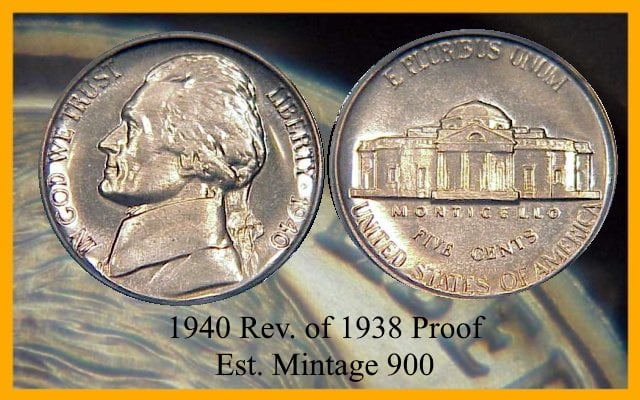
Buying this coin, I asked for a "return policy". His reply, 'Once you see this coin, you won't need one". And right he was!
At the 2:20 mark of this 1938 film, see how those raised lines were created. https://www.bing.com/videos/search?q=how+coins+are+made&&view=detail&mid=4DBC86B1D5C99F8470A84DBC86B1D5C99F8470A8&rvsmid=9DBF4FB84F1CE988510B9DBF4FB84F1CE988510B&FORM=VDQVAP

Magenta, cyan, bright gold toning! Grades higher! Lathe tool bit lines thru U. S. A.
Weak hair.




Compare the PLness above to a proof coin below.

EDS, 6 steps. Strike-thrus on the cheek.


Not exactly a high-relief/model collector coin.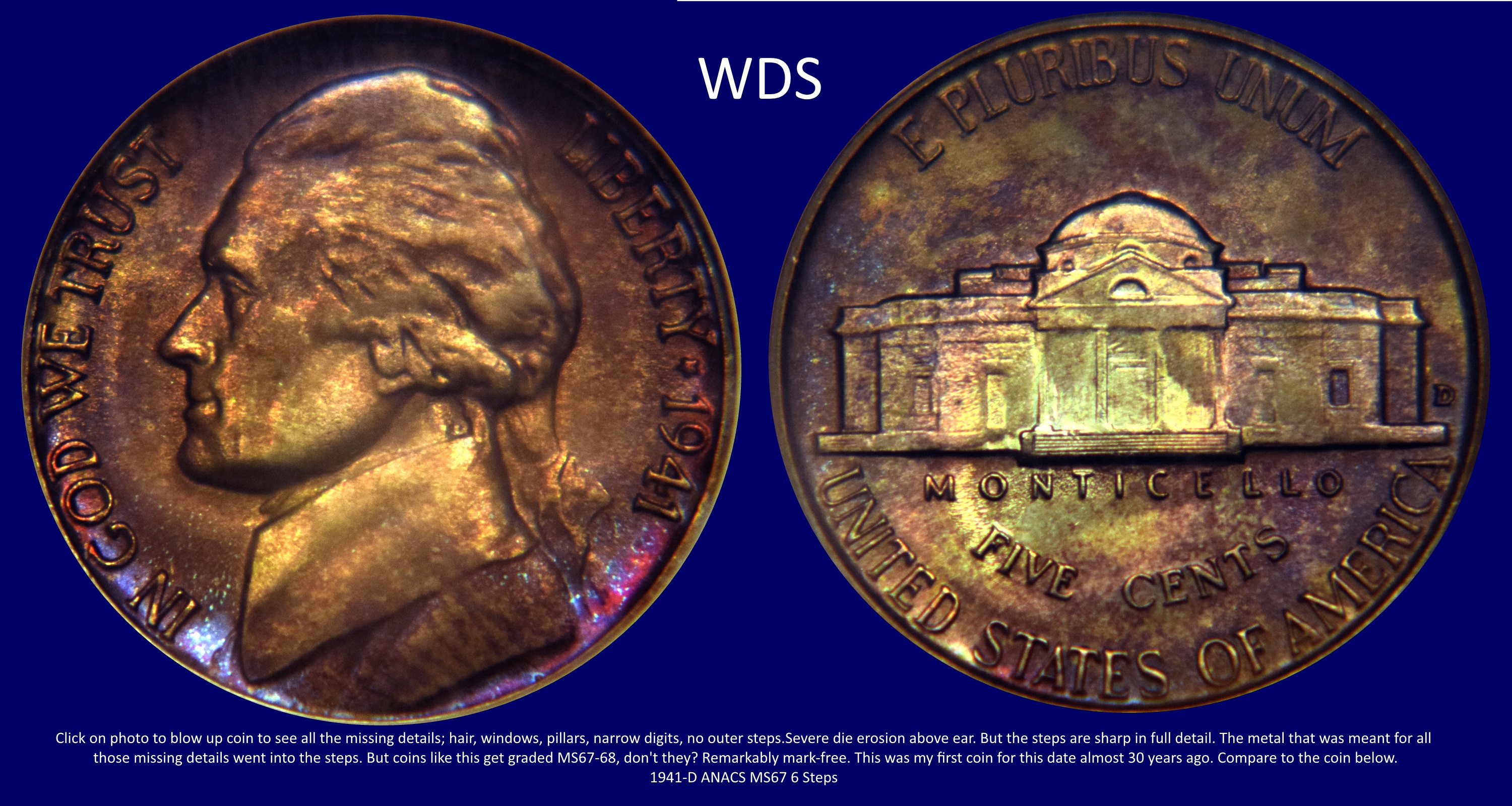
Only with a 16X loupe you might find a faint mark or two! Near perfection!
A PL business strike seldom comes mark-free and often grades low but with a satisfying amount of EA.
PL with incredible detail and toning. 


EDS. Tool lathe bit raised lines on some/segments of letters (never seen before) DDR-001 Double hub reverse EPU, USA, FIVE CENTS and reengraved EPU. Strike-thru on the cheek.
Very nice.
New photo.


Located two MS examples but sold them for good reason.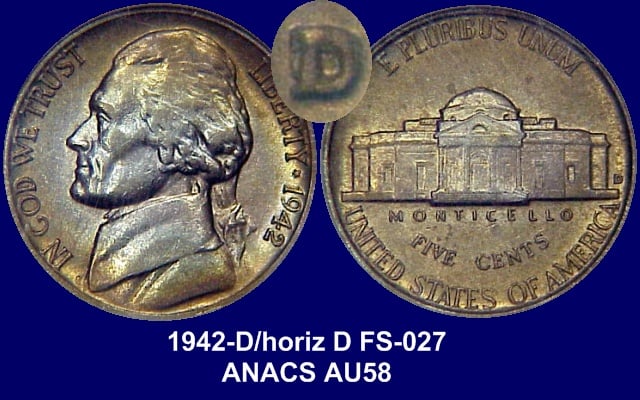


The US Mint made every effort to give collectors "collector coins". But very few realize exactly what "collector coins" look like. A great deal of time went into the design of a coin using higher coining pressure to strike/stamp well-centered, fully detailed coins in the early stages of the newest working hubs and dies. Not only for our enjoyment but to preserve our nation’s history. Coin press operators would periodically inspect the dies for wear by examining the coins insuring all the details were transferred over to the coin blanks. If not, they'd make the necessary adjustments to reduce the stress on the dies, to extend the life thereof, to strike many needed coins for circulation/commerce. Coins struck with lower pressure are the "run of the mill" or 'as struck" type coins. In 2006, the term, "as struck" replaced the term, "full strike" in the A. N. A. Coin Grading Standards. Can you recognize a collector's coin?
In searching out fully struck Jefferson nickels, experience will be your only guide as to what you can reasonably expect will be your best coin. This is great advice by Bern Nagengast who authored the book, The Jefferson Nickel Analyst. I highly recommend his book which can be found on Amazon or eBay.
"Is the coin all there?", is what I'd always say and there are many coins out there that are not. I was always searching for a coin that was just as well stuck as the 1938. I would be a liar and a fool if my coins/photos didn't back up what I proclaim.....
Whenever a coin had a nick on the cheek or a weakness in a segment of the strike, I'd think my entire collection had a serious problem. Give this some thought.
Grading standards among collectors, dealers, grading companies differ widely. Locating high-grade, EDS examples for every date won't be on everyone's short-order list to complete their collections. Why is that?
In a nutshell, these are a few things I've learned over the years.
Also, the collecting of anything can be a personal thing, as no-one will care more about what you're working towards, no one will spend more time with your coins than you.
Thanks, Leo
Here's another 1942-D
Similar to the 1946-D and 1953-D /inverted D varieties. No upright bar visible. 
A 2nd PL 1942-D. Don't worry, fingers alcohol cleaned. https://www.youtube.com/watch?v=uU4C8GbFdJM
https://www.youtube.com/watch?v=uU4C8GbFdJM
A dirty 1942-P proof.  https://youtu.be/YemdDp38a6s
https://youtu.be/YemdDp38a6s

PL, toned, strong strike, there are not rolls of PL coins to get picky with. How does a PL coin grade anyway? 

13 bands of color. Had there been less of a detailed strike, the steps would have been stronger! Far more an FS coin than.....
Every color imaginable is on this coin.

Dcam ov., Cam rv. Deep black fields and excellent contrast.

https://youtube.com/shorts/JfLM2zzic18?feature=share
FS-106 DDO


1943/2-P FS-101 SPL, Bullet strike! Strike-thru by mouth.
https://youtu.be/4c-mW9sZQX8


Dark ghost-like streaks, they appear and re-appear as the coin is tilted.
One of many coins from the Nagengast collection.
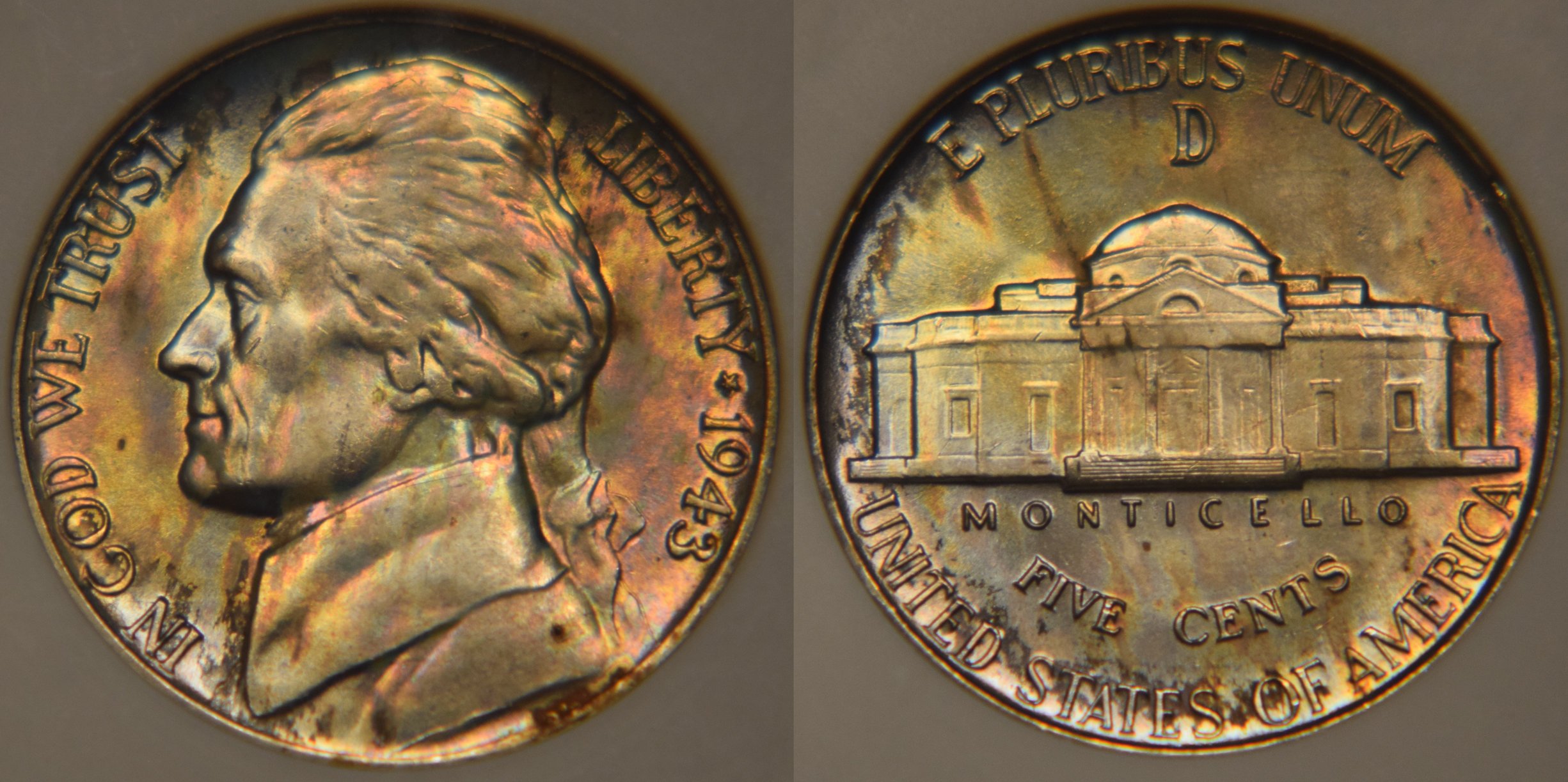
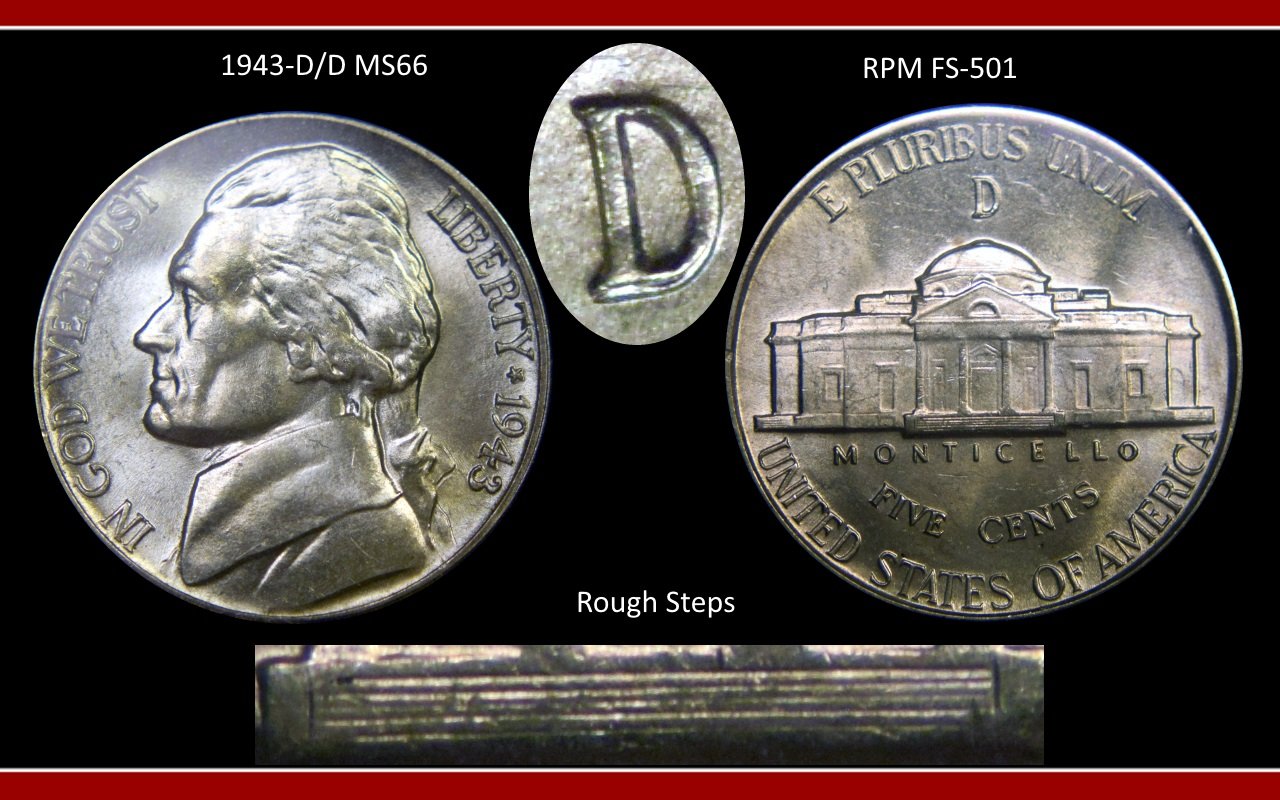

EDS, PL, colorful, high-grade FS pieces are the ultimate! 39D, 41S, 42D, this 43S not FS, 44D, 47P, 46D, 50D, 51D, 54S, 59D, 63P, 70S, 85D and a 99D.
And there are a few that aren't additionally colorful but superb they are. 


Imagine the # of nickel rolls searched. Noted "a Circ. Cam".
Makes no sense to come up with a grade for this unique PL 44-S? 
Had one grade MS68 6FS.
MS65 with "Out of this world" eye appeal! 


Obverse is more colorful than photo shows. Very strong strike for this date.
Another, had the strike been less, the steps would have been S T R O N G E R.
A softer strike gets 6.
Five war nickels are difficult to find fully struck, 43P, 44P&S, 45P&S.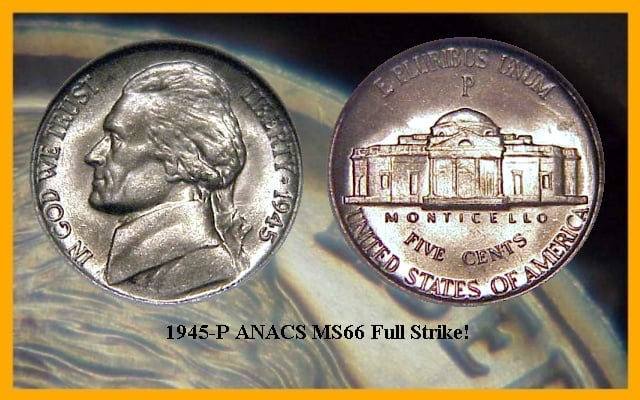

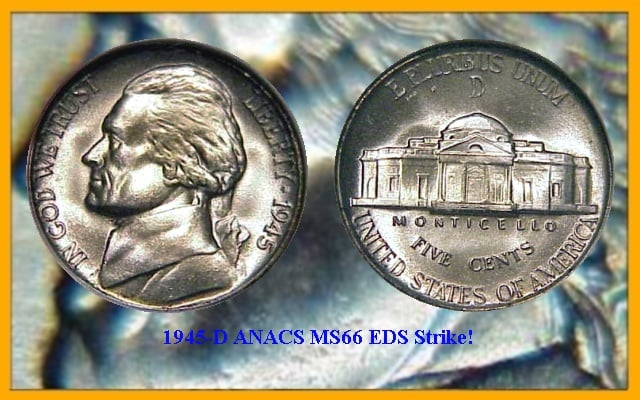

It's a matter of time before I crack it out......
A coin from the #1 PAKman Adolf Weiss. 
1946-P w/6 steps, PL ov. 


Was a PCGS MS64FS, cracked it, NGC said, questionable color. Ha, ha!. Strike-thrus on cheek and 6 steps. Strike is not EDS. Subtle luster. 5-6 hidden marks. 
How well the fields curve up to the rim, gives us a deep dish or spoon-like effect. A very difficult quality to photograph. Gold toning with touches of lavender with nice luster. A better pic is needed. 



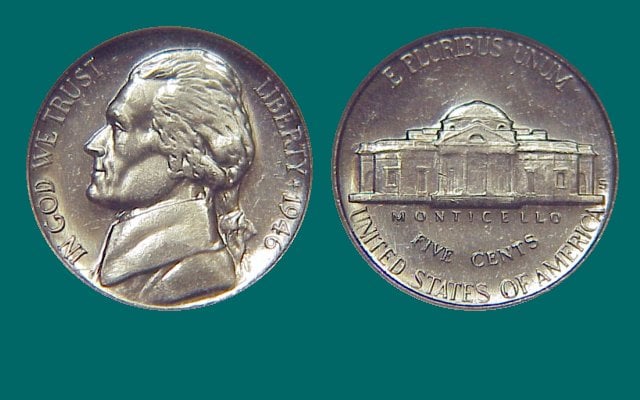


Bold, deep-dish strike prevented FS.


EDS, SPL. Peripheral lathe lines on Reverse. DDO. More colorful than pic shows.
Not fully struck, big nick on cheek. Some coins have greater eye appeal at arm's length than 5X.







Better example.
A lower grade but with nice color, luster, strike and 6 steps! ![]()


I used to think these were incused (sunk-in) die polish lines (DPL), work was done to the working hub but they are raised DPL.
Would they reuse a rv. working die from 1948 again in 1949?

Toothpick Thomas variety (My discovery?) See CoinFacts for a 2nd example.
Had the dies suffered more wear, the steps would be fuller.
1949PDS are tough dates to find with full design features.


Rare bold strike,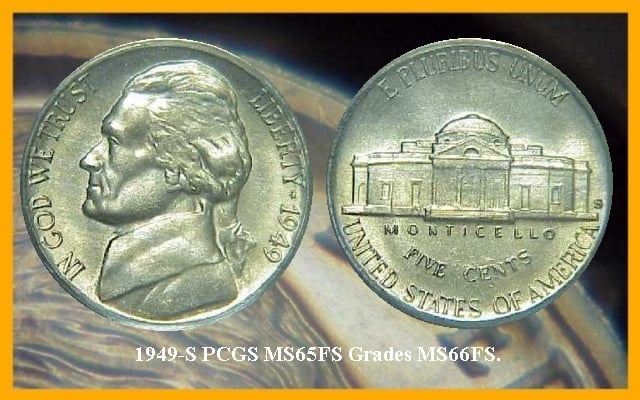
Only nick on the entire coin is on the steps. Rarely seen with a strong strike!

SPL. Lathe lines circumference the entire obverse. When all the details of the 1938 m-hub are captured on a much later date, the image is older than the coin itself. Collecting coins became ....can I find that original strike again!
Locating VEDS examples after 1943 became challenging!. Then, in 1950, the strike improved! I believe the US Mint made new Master dies from the Master hubs every 8 to 12 years. 1938, the 2nd in 1950 and 1960, possibly earlier, see 1958-D! The old Master Hubs of 1938 were retired/replaced in 1971. Strike-thru on coat/collar.


Prooflike.....indeed!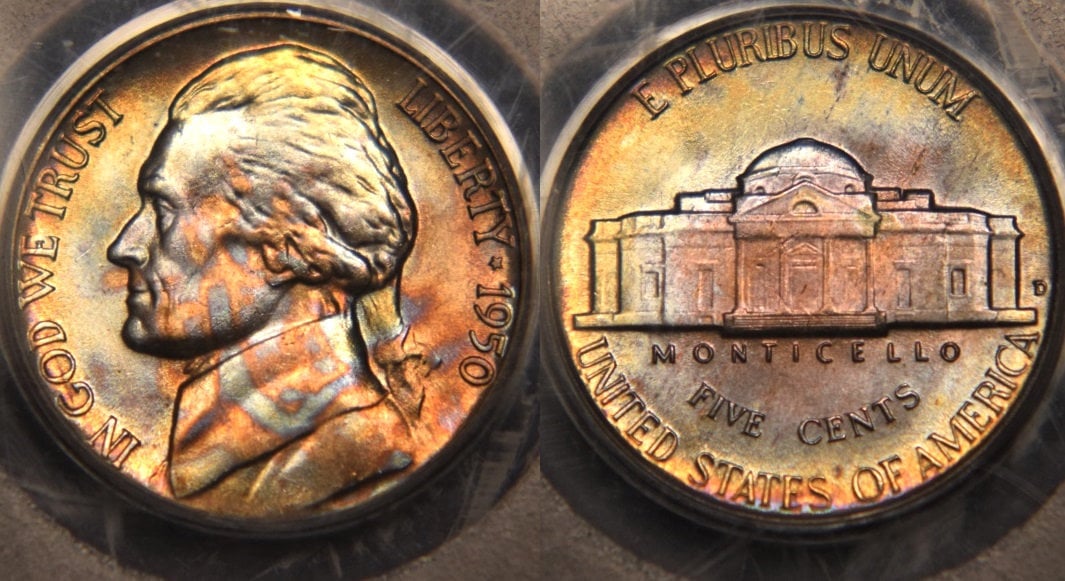
 https://youtu.be/W1Un40C-0bA
https://youtu.be/W1Un40C-0bA
Lathe bit raised lines at 2:00 to 5:00. The prevalence of 6 steps, subtle golden luster, an EDS strike.
1000's of unc. rolls were saved of this low mintage date. ANACS certified only two 6 step ex. 

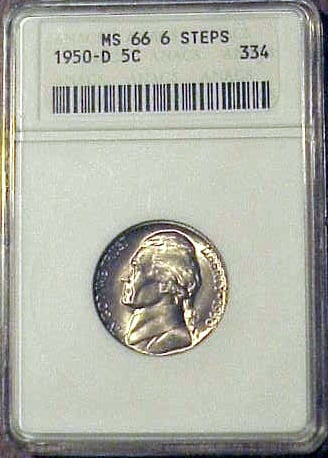
Low grade.



Lustrous!
PL but marky ov. for a MS67.
https://youtube.com/shorts/oRYCpCcAA40
EDS strike, mirrors, frost! 

EDS, pristine 1950 to 1970 ex. are extremely difficult.... 
2nd 1951 PCGS MS66 PL, Photo soon.
This 1952 is PL

MS68FS quality?

PL
SPL.

1st coin ANACS certified, MS65 5 Steps. Q2+ notes the strike, condition, perhaps the toning. Luster is subtle, natural due to an EDS strike.
PL






Used to own an MS65FS. 2nd best in strike, grade and steps!
75+ years behind searching for an EDS 1953-S, my 34 plus 45 more of another collector.
Is there a higher-step example with this much detail out there? The coin to beat!
Only the 2nd example I've ever seen!

EDS strike, lustrous, hints of lathe lines, strike-thrus on Jefferson. Grades higher!
No perfect steps but the strike, condition and toning are nice. ![]()


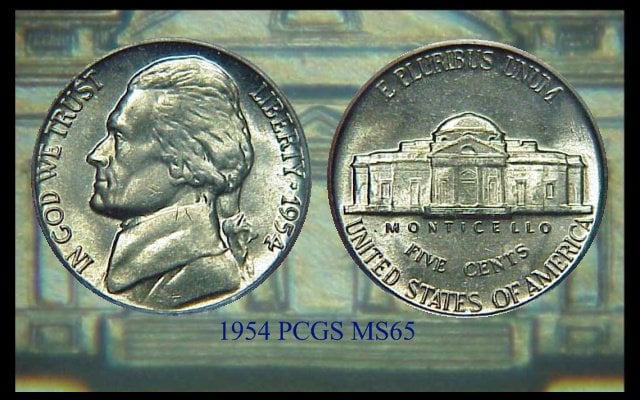



An EDS or fully detailed FS example is unknown. Best in strike, grade and steps.

Same coin.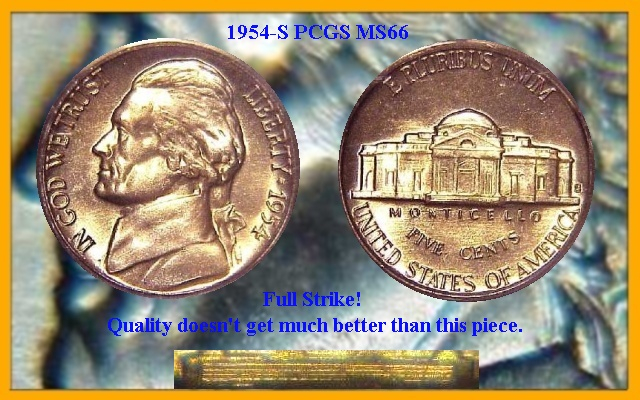
PL with remarkably clean surfaces.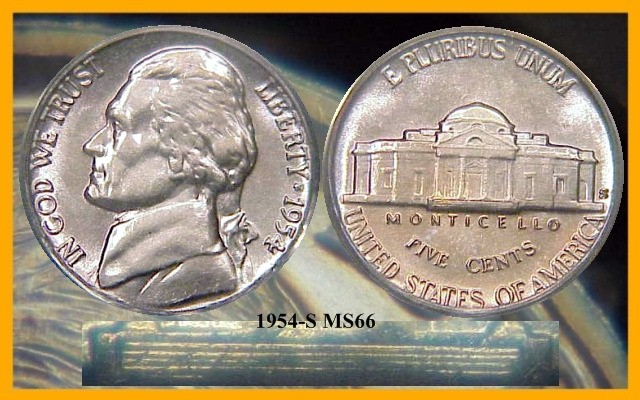
PL Beautiful T. 
Raw example, EDS strike, SPL ov. 5544 QSC. two small strike-thrus on steps, Hit on cheek and rv. Some color. $125. Use the private message, PM option.
A slider! Above examples with full overall strikes but w/just-miss FS are rarer to find but frequently valued less than coins w/weak details, stronger steps?
Below PCGS MS65 example w/TV, w/nice steps but not FS. For sale. $485
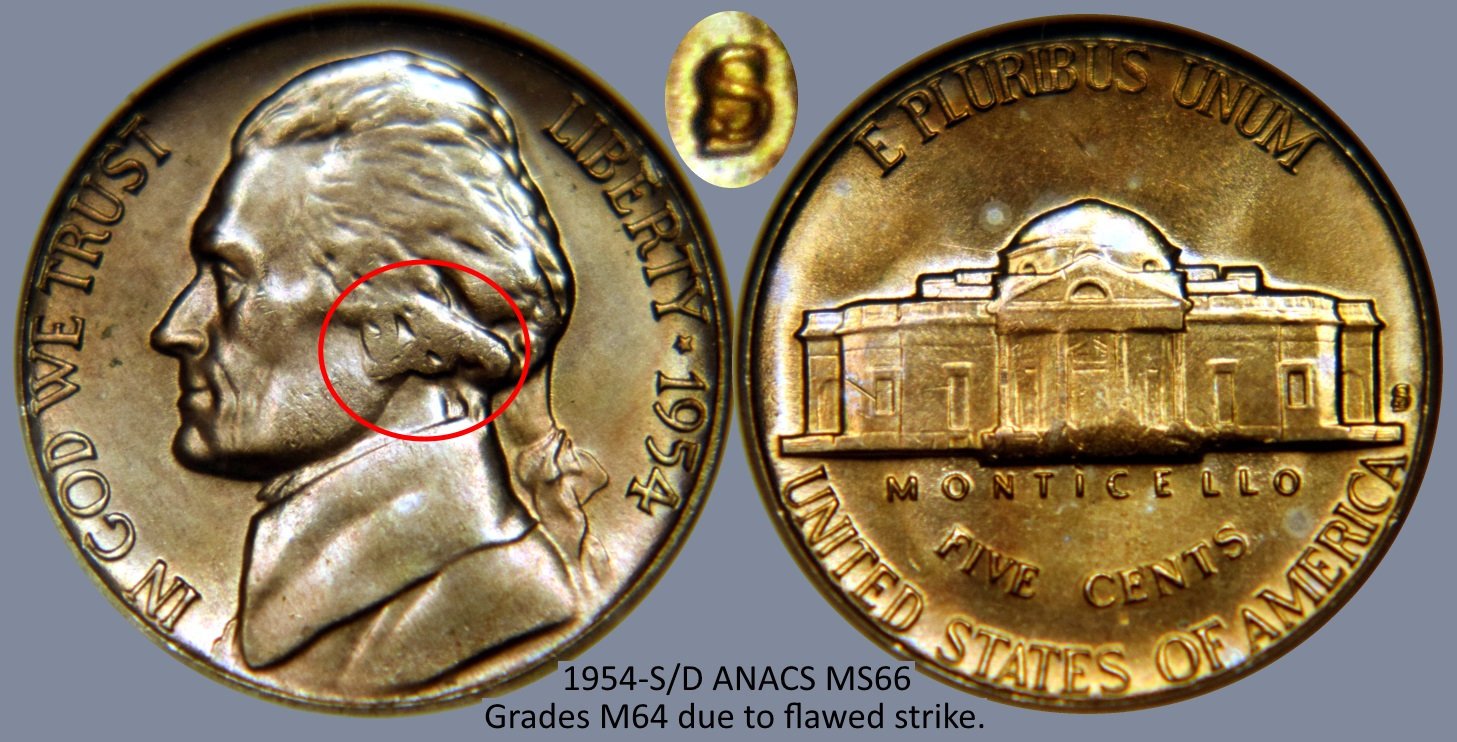

A rare white example!
Exceptional.
Tough date with or without nicks on the steps!
A sleeper.
Slab-Renew removed the scuffs.



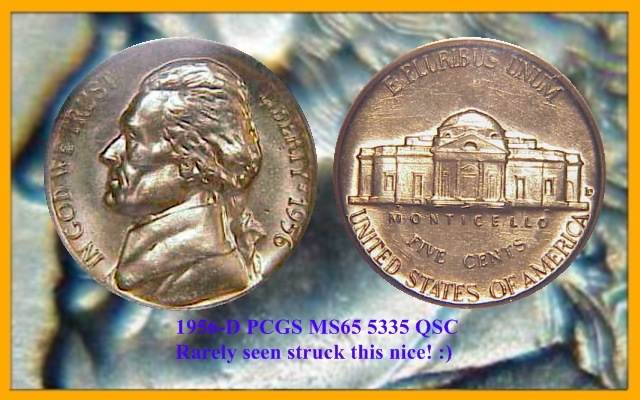
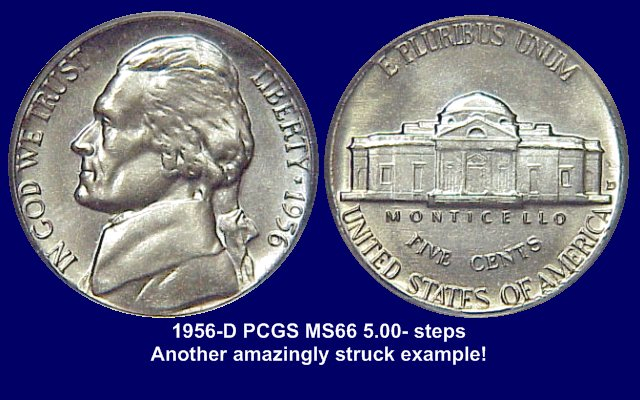

Raw example w/nice luster, strike and steps...strike-thru on steps, not a nick. $295 or make an offer.
Open pic in a new tab by right-clicking to view a much larger picture!
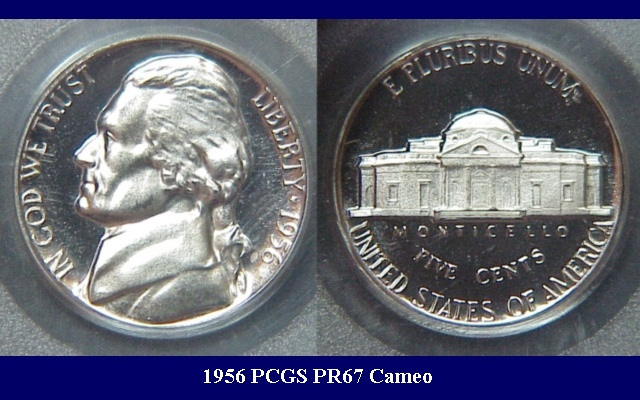
Very tough dates to find w/full details.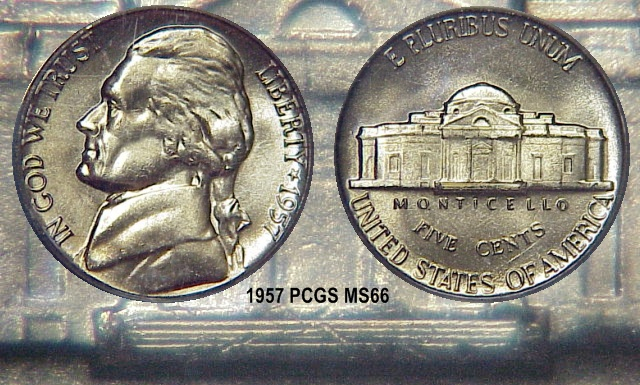


Flat ear/flaw alert!

A black beauty has PL fields.
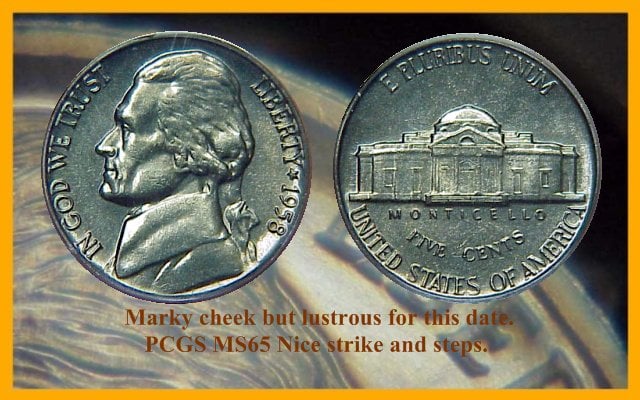


SPL Colorful

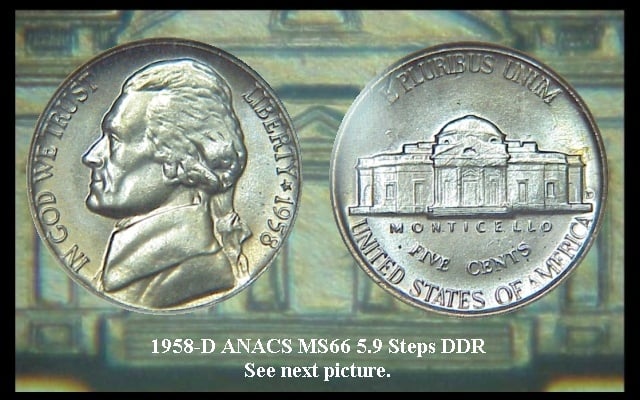

For lathe lines to appear on a coin after 20 years........most will never understand.....
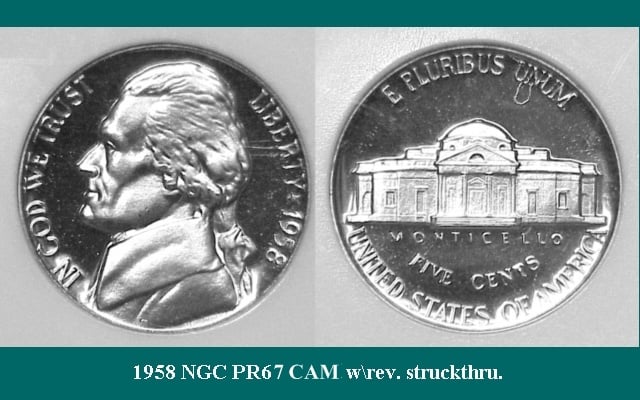
Had a 59-P ANACS MS66 5 cross to PCGS Pop 6/0 and into a top Registry set.


PL coins seldom grade high. 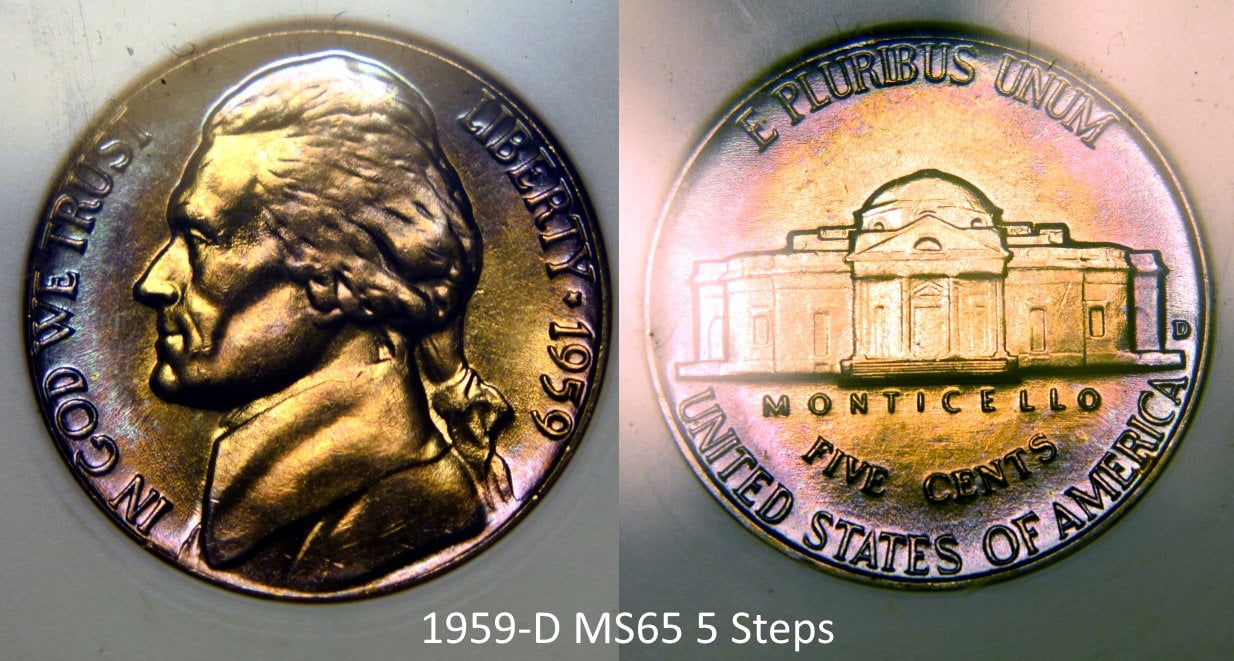




Last of the 6 steppers, 22 dates, 1938 to 1970 set.
Tough stretch of 1960's dates in strike, condition, steps! A lifetime......effort!
https://forums.collectors.com/discussion/628044/an-analysis-of-the-1960-1967-jefferson-nickels-steps
1960-P with a nice strike. $65

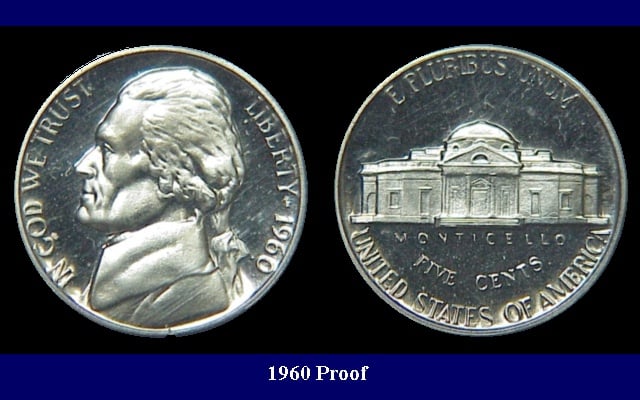
1960-D Jefferson nickel for sale, $35,000 or best offer. A strike-thru occurs at the time a coin is struck/minted. The mark on the steps is just that, a strike-thru and not a nick. Most collectors don't have anything close in FS. An extremely rare coin to collect. 

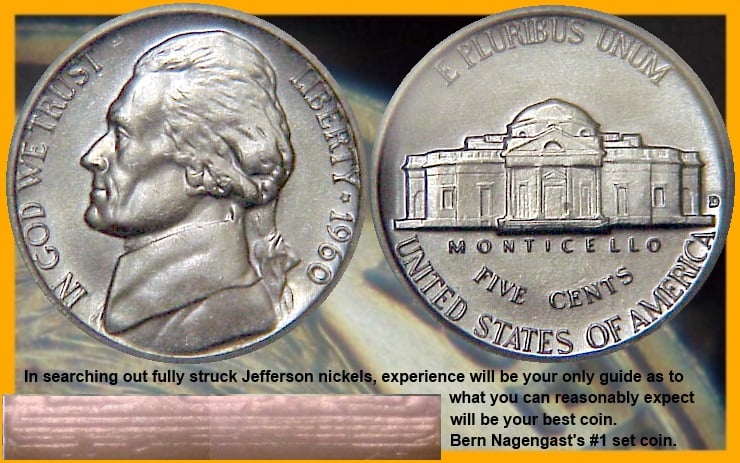
Lt. gold, lustrous with touches of lavender toning. MS65+ IMO. Exceptionally nice! 

Very colorful!
PL! No flat cheek or ear. Full hair, Mont. details. Resembles 1938 Master hubs, 24 dates/23 years. Short 4 quarter steps! Had the overall details been less, the steps would have been stronger and likely would have lost its PL fields.
Same goes for the above coin but shy only 2 quarters; 4/3 and 5/3, 5/4 is just short of.
"Best strike, condition and steps!"
Black Beauties have PL fields. Deep dish strike. Extra light on photo. 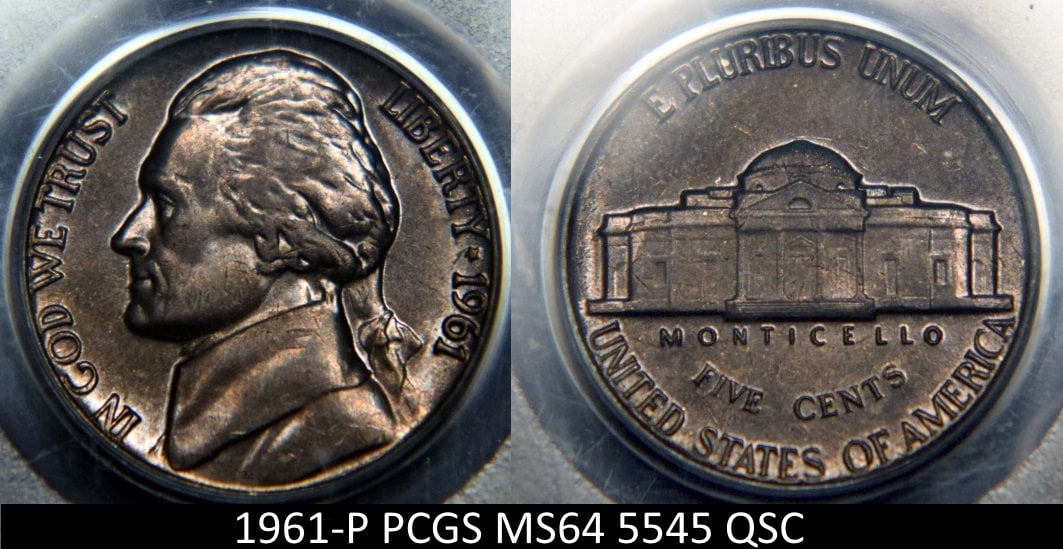
Quarter step shy. Have others w/5 steps. Best strike, grade and steps! 




1963D Jefferson nickel Full steps for sale. $2195 obo


With over a billion made, an excellent 1964-P. 

FS $55.

Cracked out! Spot removed! Now grades MS65 5 steps!
Soft details. Late die set. PL.
For dates, 1965-1970-S, SMS, Proofs and BS coins, are all products from the same dies. And possibly a collar change. Also, the dies/steps were improved for 1967 SMS coins only, not for the BSs which raises a question......
The next 2 shed new light on how SMS dies were prepared to strike BSs..... sandpaper!
An unexpected piece!

Weak strike, die erosion in hair, not anywhere near as nice as the 1965 above, but hey, steps! ![]()
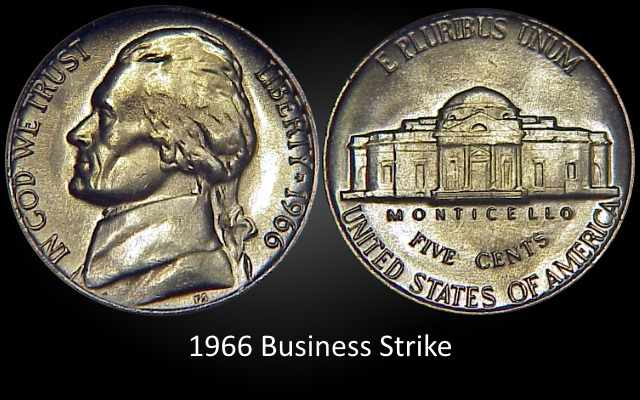
1967 PCGS MS65 QSC 3325 Strong quarter steps, add in the weak ones, 4345? $219
FSNC #1 PAKman Adolf Wiess declared a 1967 BS with FS does not exist.
1,000,000 yrs by an est. 28,000 coll. over the last 56 years have searched.....deep hairlines, cherry cheek, sharp window tops BUSINESS STRIKE (BS), NOT SMS. Is there a finer example!!
The small strike-thru caused that small segment of the 6th step just beneath it to appear.
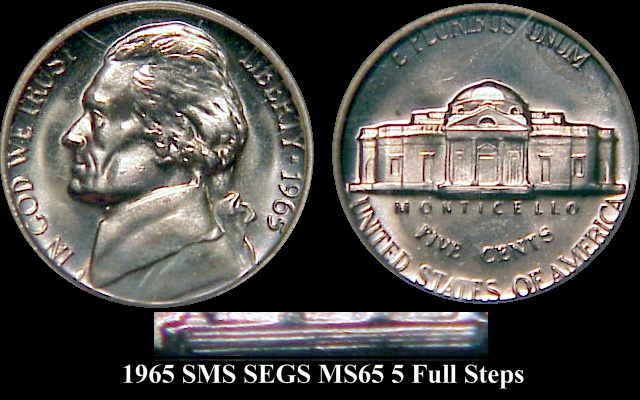


SMS FS?
Stunning details due to a bullet strike! Show me a better example!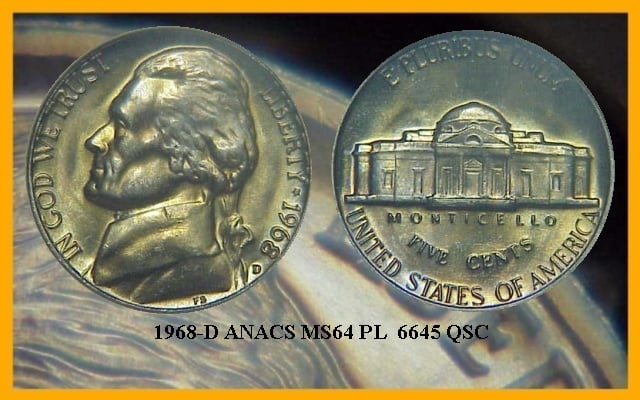
From the Bill Fivas collection. Five steps noted by ANACS. Did I mention it's PL?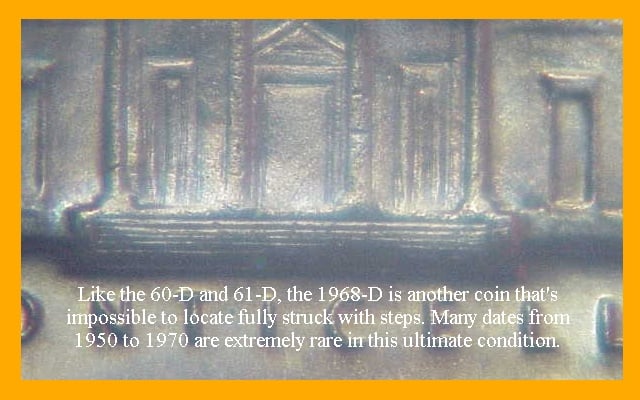

Strike-thru on steps. 
Strike thru, 6545 QSC. TV $159
PCGS MS65 6645 QSC Old TV


Another "needle in a haystack find" 1969-S in a PCGS MS64 holder with a QSC of 6646 but also with a HUGE strike-thru. 

A miserable example. MS62 W/str 4333 QSC

Amazing detail for the last strike of 33 years use of the 1st set of Master hubs.

The early set ends in 1970, not 1964! 1970 was the last year/date the U. S. Mint struck coins from the 1st set of master hubs. New hubs were cut in 1971. Remember this when building your sets.

Thank you!
Leo
**Corresponding through the PM Inbox **
https://www.usmint.gov/learn/history/us-circulating-coins
https://www.usmint.gov/learn/production-process/die-making#:~:text=The average life of a die varies based,the final adjustments to be ready to use.
Individual coins in bold print listed for sale.
2-1954-S, 1956-D, ,1960, 1960-D,1963-D, 1964, 1967 BS, 1968-S, 1982-P & D Reverse of 1977 Type 1 pair
Comments
Wow Leo,I know how long it's taken you, and also how particular you are. I know those are your babies and I wish you the best of luck!
I have learned quite a bit about Jeffersons through your posts over the years, what is it you are showing us with the close ups of the rim in a few of the photos? Interested.....
Lincoln set Colorless Set
Very nice, I commend you on the time and effort it must have taken you to put this collection together, good luck !!!
Beautiful set
RAD#306
Thanks for the great reviews guys. In the following, ' How coins are made; https://www.bing.com/videos/search?q=how+coins+are+made&&view=detail&mid=4DBC86B1D5C99F8470A84DBC86B1D5C99F8470A8&rvsmid=9DBF4FB84F1CE988510B9DBF4FB84F1CE988510B&FORM=VDQVAP Sadly, someone has removed access to....
Those raised lines on the rim were made by a cutting lathe bit which leads me to believe a coin has a very early die state (EDS) strike. The 1939-D Type 1, 1940-P, 1950 and 1950-D 6 steps and a few others have these tool die markings. I like to think they cut 3 sets of master dies. A set for 1938 to 1949. Another for the 1950's. And the last set for the 1960's. I have an EDS 1960 example but no lathe lines.
Also, low luster fields is another indication of an early strike. The very first few coins struck with brand new fresh dies will lack the metal flow lines that manifest luster. One can see this effect with just about every 6 step example in this set.
Leo
The more qualities observed in a coin, the more desirable that coin becomes!
My Jefferson Nickel Collection
Wow, What a collection, I must have spent 50 minutes looking thru your photo's. Would love to see more... Please.
Leo, Are you looking for offers on individual coins, or are looking to sell as a set?
I'm accepting offers for the entire collection and not for individual coins. My apologies. This is a special collection of fully struck to EDS coins, some 6 steppers and a few proof-like coins, a few very nice proof coins.
But don't be shy to message or email me if you have interest, I have duplicates aside from the main collection.
The more qualities observed in a coin, the more desirable that coin becomes!
My Jefferson Nickel Collection
nice nice, thnk you
Am I reading the asking price for the whole set correctly? Two million dollars?
You have a "special collection" of Jefferson Nickels, a set you're asking 2,000,000 for, but you won't break it up. Your wife needs lung transplant, so you have started a gofundme for your wife, but openly tell people you won't be able to pay the donors back. Good luck.
Moved up into the collection.
The more qualities observed in a coin, the more desirable that coin becomes!
My Jefferson Nickel Collection
Beautiful Jefferson's, dude. I admire all of your's! Love the way you show the display. So attractive and professional.

"Jesus died for you and for me, Thank you,Jesus"!!!
--- If it should happen I die and leave this world and you want to remember me. Please only remember my opening Sig Line.Here's my latest addition.

Leo
The more qualities observed in a coin, the more desirable that coin becomes!
My Jefferson Nickel Collection
Very nice set. You have a great eye.
Pedigree: Bern Nagengast.

The more qualities observed in a coin, the more desirable that coin becomes!
My Jefferson Nickel Collection
Incredible!!!!
I just looked at every coin in the set and thought to myself the only coin in it that isn't top notch is the '67.
Your new one is.
I haven't seen all of these in top condition BU but I've seen them all in XF to BU.
I recently sold a '70-S that was top notch and just a whisker away from being as nice as the one you have here judging by the photo.
The '67 actually comes fairly nice but getting one with a nice crisp strike and FS that doesn't have marking is tough. Some nickels seem easy but actually putting your hands on them is almost impossible. The later dates (post-'70) are easier clean and with full steps but almost all of them have planchet marking and chicken scratches.
Everyone says Ikes are the toughest moderns but I've always found solid Gem nickels are harder. FS are tough for many dates even back to the first issues when they circulated with still shiny buffalo nickels.
A real beautiful collection and only you know how much time it took to build it. Congratulations, loved looking at all your photos, and that must have been enormously time consuming. I think I'll have go back and take another tour of the photos. Thank you for this great post.
USN & USAF retired 1971-1993
Successful Transactions with more than 100 Members
A herculean task that was completed with pride and skill. Congratulations. I respectfully feel I should pay you just for the privilege of viewing this spectacular collection. Thank you for taking the time to share with us.
You have some great coins there! You might consider selling the proofs separately though.
Wow...beautiful collection. And a very informative post, I took some notes! Thanks for taking the time with your listing and good luck with the sale!
K
Dyk, fewer than 3% (9 or 10) of the 300+ early Jeff proofs, 1938 to 1942-P in CoinFacts have the rare greens, gold and reds on both sides.

Leo
The more qualities observed in a coin, the more desirable that coin becomes!
My Jefferson Nickel Collection
Do you have any Henning nickels?
Disclaimer: I'm not a dealer, trader, grader, investor or professional numismatist. I'm just a hobbyist. (To protect me but mostly you! 🤣 )
@leothelyon, and I thought I had done a lot of work! Wow! This is like a book! Amazing! Thank you for sharing the link. I saw other broadtruck nickels too! Sincerely, Greg.
New addition.

Leo
The more qualities observed in a coin, the more desirable that coin becomes!
My Jefferson Nickel Collection
Thanks for the great post, I put a raw bu set together and thought that was amazing but your set is overwhelming with eye candy! Thanks again for sharing.
WOW. Super Nice Collection
USN & USAF retired 1971-1993
Successful Transactions with more than 100 Members
Not all freshly made working dies would show all the designer's/sculptor's original details on the first coins stamped. The last pair of working dies made from a set of working hubs would not have the finer detail of a pair of working dies that were made earlier in the life of those same working hubs.. The US Mint would spend just as much time maintaining the working hubs as they did with the working dies. So a PL example won't always have complete details.

The first working dies made from the first of early working hubs produced your very earliest of die state (VEDS) strikes on coins.
My latest addition, shows all the intended details of the sculptor's works and more.
Open my latest addition in a new tab to see all the details, some frost and many lathe lines. And the one cheek mark for a MS66 grade? Near perfection.
Comments are welcomed.
Leo
The more qualities observed in a coin, the more desirable that coin becomes!
My Jefferson Nickel Collection
Raw example w/nice luster, strike and steps...strike-thru on steps, not a nick. $295 or make an offer.

PCGS MS65 example w/TV, w/nice steps but not FS. For sale. $485

Right-click on pics to open up a new tab for a much larger picture of the coin.
Individual coins in bold print listed for sale.
2-1954-S, 1956-D, ,1960, 1960-D, 1963-D, 1964, 1967 BS, 1968-S. 1982-P & D Reverse of 1977 Type 1 pair
Leo
The more qualities observed in a coin, the more desirable that coin becomes!
My Jefferson Nickel Collection
I've been lucky to have located just two fine examples of this date in almost 35 years. This one is likely the only one being offered at this time anywhere! Raw coin, rarely offered, asking $2195 If two or more express immediate interest I'll consider the offers and inform the parties. Use the private message, PM in upper right corner on this page and I think click again on the next page to make the message private. You might want to send a test message to be sure. Leon

Some of the coins I have to offer just may be the best examples most collecters will ever see in their lifetimes.
The more qualities observed in a coin, the more desirable that coin becomes!
My Jefferson Nickel Collection